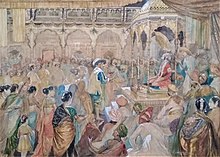|
Ashta Pradhan
 Ashta Pradhan (literally, 'Council of Eight') was the cabinet of the Maratha Confederacy.[1] The council is credited with having implemented good governance practices in the Maratha heartland, as well as for the success of the military campaigns against the Mughal Empire. ConstitutionThe coronation of Shivaji was held in 1674, at the fort of Raigad in present-day Indian state of Maharashtra. On that occasion, Shivaji formalized the institution of a council of eight ministers to guide the administration of his nascent state. This council came to be known as the Ashta Pradhan. Each of the ministers was placed in charge of an administrative department; thus, the council heralded the birth of a bureaucracy. The formalization of an administrative mechanism was of a piece with other measures, indicative of the formalization of a sovereign state, which were implemented on the occasion of Shivaji's coronation: coinage bearing his insignia (the copper Shivrai and the gold hon) were issued, and a new era, the Rajyabhishek era, was proclaimed on the occasion. CompositionThe Ashta Pradhan was designed to encompass all the primary administrative functions of the state, with each minister being given charge of one role in the administration. Ministerial designations were drawn from the Sanskrit language; the eight ministerial roles were as follows:
Continued conflict with the Mughal Empire meant that military matters remained exceedingly important to the affairs of the nascent state. Hence, with the notable exception of the priestly Panditrao and the judicial Nyayadisha, the other pradhans held full-time military commands, and their deputies performed their civil duties in their stead. In the later era of the Maratha Empire, these deputies and their staff constituted the core of the Peshwa's bureaucracy. During Shivaji rule
After ShivajiShivaji son Sambhaji, (ruled 1680–89) reduced the powers of the council. Over time, council positions became hereditary, ceremonial positions at court with nominal powers, if any. Beginning 1714 AD, a prime minister appointed by Shivaji's grandson Shahu gradually arrogated power. Within a short period, de facto control of the Maratha state passed to his family. This family of hereditary prime ministers retained the title of Peshwa. However, the Ashta Pradhan council was never revived to fill the functions it discharged for the last decade of Shivaji reign. Positions Equal to the AshtapradhanAlso See: Khando Ballal Chitnis
Also see: Bahirji Naik
Miscellany
References
|